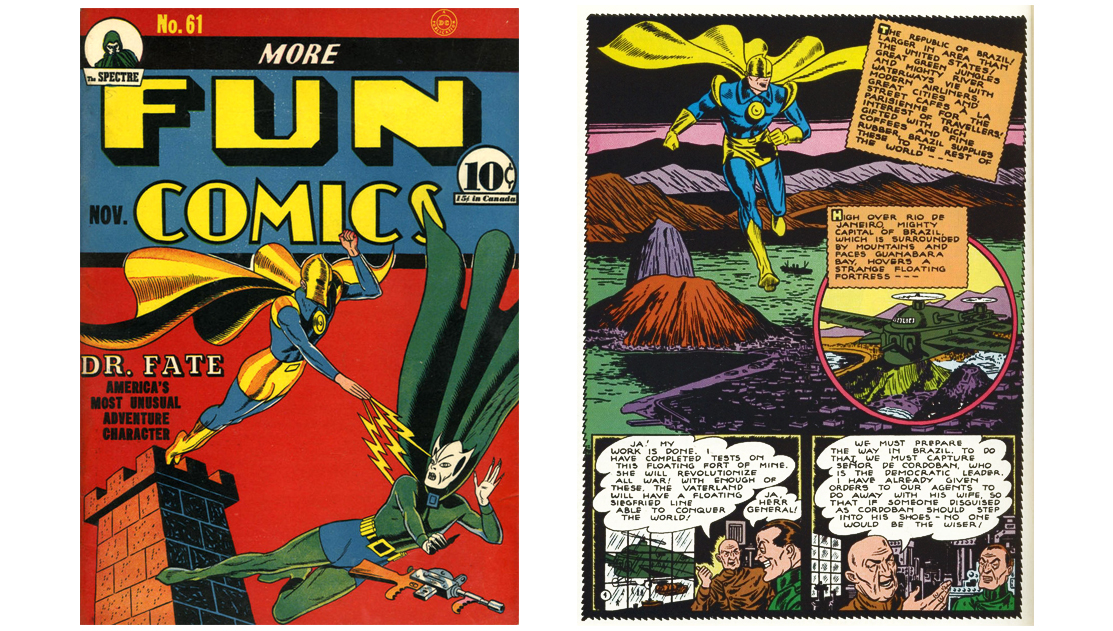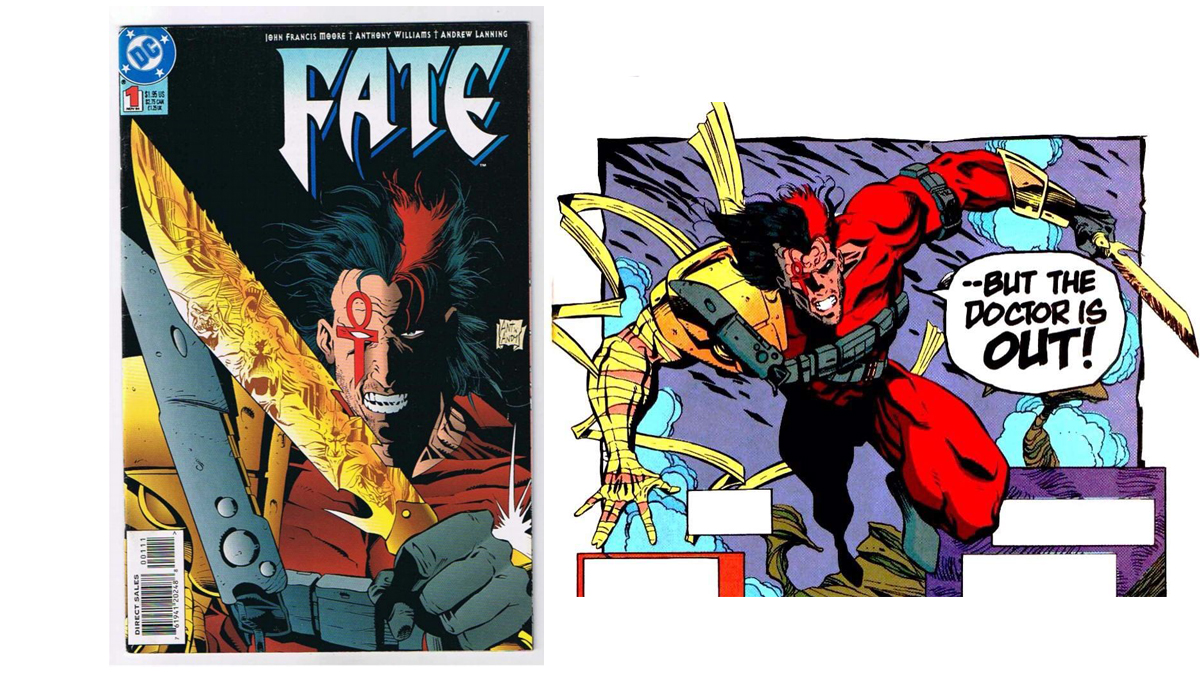In a genius bit of “chef’s kiss” casting, Warner Bros. and DC Films announced that former James Bond 007 Pierce Brosnan is joining the cast of Black Adam as iconic sorcerer superhero Doctor Fate. He rounds out the Justice Society of America heroes who will appear and fight Dwayne “the Rock” Johnson as the titular antihero. But casual fans might not be familiar with with DC’s sorcerer supreme, who debuted a whole two decades before Marvel’s Doctor Strange. Read on for a breakdown of the complex eight-decade history of DC’s most powerful magic-based hero.
The Golden Age

DC Comics
Writer Gardner Fox and artist Howard Sherman create Doctor Fate in 1940. He first appears in More Fun Comics #55 in May of that year. Fox also co-created the original Flash, as well as Zatara the Magician. Decades later, he’d created Zatanna, another powerful magic user. (It seems stories about heroic wizards were his strong suit). Clad in a gold cloak and gold helmet, Fate used his magic to fight criminals, in several short stories in the anthology title.
Fate’s magical abilities were pretty much off the charts. His spell-casting allowed him to fly, teleport, wield super strength, astral project, fire mystical energy bolts, cast illusions, and use telepathy, telekinesis, and pyrokinesis—you name it. With all of these powers, there was very little he couldn’t do, making him perhaps as OP as Superman. Despite all this, he never took off as a character on the level of the Man of Steel, Green Lantern, or the Flash.
The Origins of Fate

DC Comics
In 1941’s More Fun Comics #67, readers learned about Fate’s origin for the first time. In 1920, an archaeologist named Sven Nelson took his son Kent with him on an expedition to the Valley of Ur in Egypt. While exploring the ancient temple his father discovered, Kent opened the tomb of the ancient Nabu the Wise. This awakened Nabu from his mystical slumber, but also released an ancient poison gas by mistake, killing his father Sven.
This story was a reference to the “ curse of King Tut’s tomb,” which was popular folklore at the time. When archaeologist Howard Carter discovered King Tutankhamen’s tomb in 1923, several members of the archeological party died mysteriously, leading to the popular modern myth. Clearly Gardner Fox used that as his template for Doctor Fate’s backstory.

DC Comics
The wizard Nabu the Wise, a Lord of Order, felt responsible for what happens to Kent’s father. So he took the young boy on as a sort of adopted son. Over the next two decades, he instructed him in the ways of sorcery, and finally bestowed on him his mystical helmet, amulet, and cloak. Kent then moved to America and became a magical superhero named Doctor Fate. Soon after, he became a founding member of the Justice Society of America, comics’ first super team.
In his very first adventure, Doctor Fate rescued a woman named Inza Cramer from a wicked sorcerer named Wotan (who went on to become Fate’s biggest nemesis). The two married soon after that and moved into a mystical tower in Salem, Massachusetts. (Where else does one put a mystical tower?) Fate managed to use his magic to cloak his tower from mortal eyes. Due to their magical knowhow, Kent and Inza retained their youth and vitality for decades.
Modern Age Revival

DC Comics
Doctor Fate’s early comics career was relatively short-lived. In just four years, he vanished from JSA stories and lost his own feature in More Fun Comics. But two decades later, in the Silver Age of comics, Fate made a comeback. When the Justice League of America discover their Earth-2 counterparts the Justice Society, Fate was one of their members. He appeared regularly in the JLA/JSA crossovers, and also showed up as a guest star in various stories for the next few decades.

DC Comics
After decades as a secondary hero and occasional magical ally to more popular characters, Fate got a boost in popularity in the ’80s. Someone in charge at DC must have really liked him at the time, because he got a back-up feature in the pages of The Flash. He also got his own mini-series The Immortal Doctor Fate, his first time headlining a comic of his own. When Kenner Toys released their Super Powers action figure line, Fate was the only JSA hero in the group. And he played a big role in DC’s seminal even series Crisis on Infinite Earths. After that series, he graduated to the big time, officially joining the Justice League.
The Many Inheritors of the Fate Mantle

DC Comics
Then, things got weird for the character of Doctor Fate. Kent Nelson died, and the mantle of Fate passed on to Eric Strauss, and his stepmother Linda. The two merged into one being, and this new Doctor Fate got their own ongoing title at last. Kent’s body was still around, as his corpse had become the home of the spirt Nabu, who advised the Strauss versions of Doctor Fate. The second Doctor Fate didn’t last long, and they died at the hands of a Lord of Chaos. Kent Nelson and Inza Nelson were resurrected, and merged to become a new Doctor Fate (presenting as female). They too are soon killed, in DC’s Zero Hour event in the mid-’90s.

DC Comics
The third Fate was then replaced by the most “extreme” ’90s comics cliché character ever, Jared Stevens. Jared melted down the helmet and amulet of Doctor Fate and transformed them into a dagger and throwing stars. He used the cape of Nabu to wrap around his arm, giving him mystical strength. There was even an ankh tattoo over his eye. He had his own comic for a time as a heroic demon hunter, titled simply Fate, and later, The Book of Fate. Its run was relatively brief, and Stevens died soon after. His mystical artifacts returned to their original forms, awaiting a new bearer.

DC Comics
The 21st century saw a string of new Doctor Fates. The original Hawkman’s son, Hector Hall, becomes the new Doctor Fate in the Justice Society of America revival. He lasted a few years, and was soon succeeded by Doctor Kent V. Nelson, the original Kent Nelson’s grandnephew. In DC’s New 52 reboot in 2011, the new Fate was Khalid Ben-Hassin, the previously unknown grandson of Kent Nelson on Earth-2. A few years after that, an Egyptian-American medical student named Khalid Nassour took the mantle. It turned out that he was Kent Nelson’s great grandnephew.

Warner Bros.
There’s been little representation of Doctor Fate in most media outside of comics. The original Kent Nelson version has appeared in the DC animated universe; first, in Superman: The Animated Series, and later, Justice League Unlimited. His most recent animated incarnation was in Young Justice. In live-action, he’s appeared only once, on Smallville. But with Pierce Brosnan soon to wear the helm of Nabu, his popularity is sure to skyrocket. For fans of DC’s mysterious magician, his turn at the spotlight is long overdue.
Featured Image: DC Comics